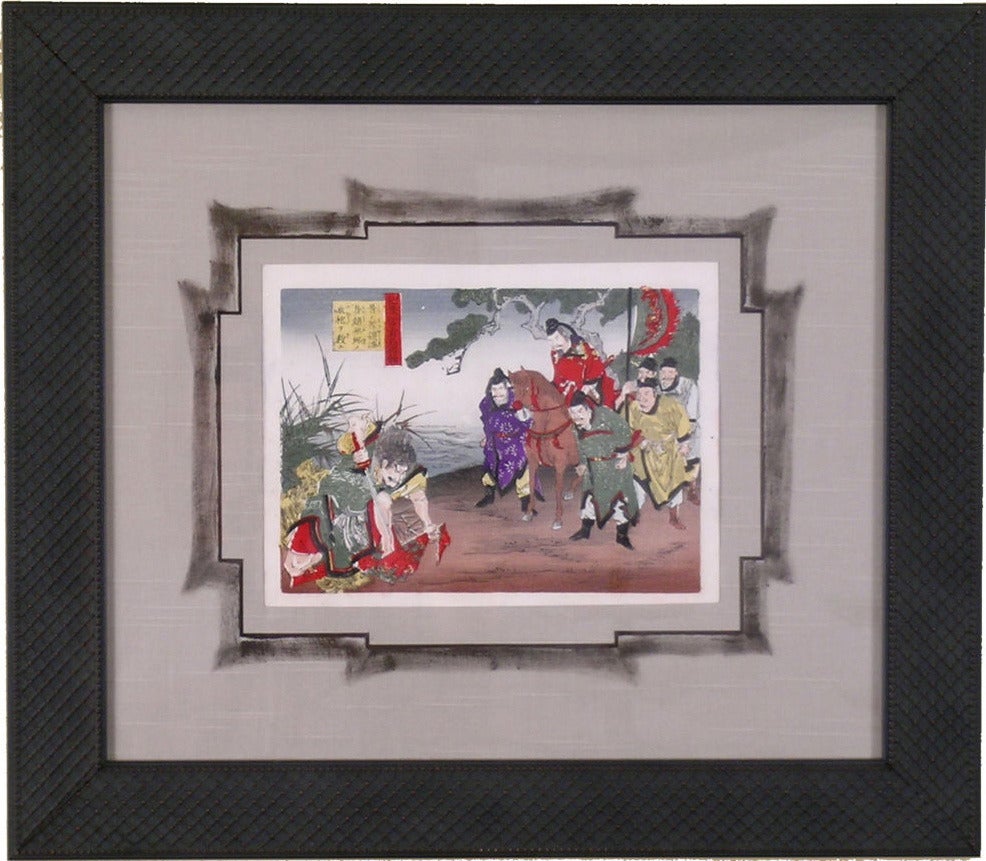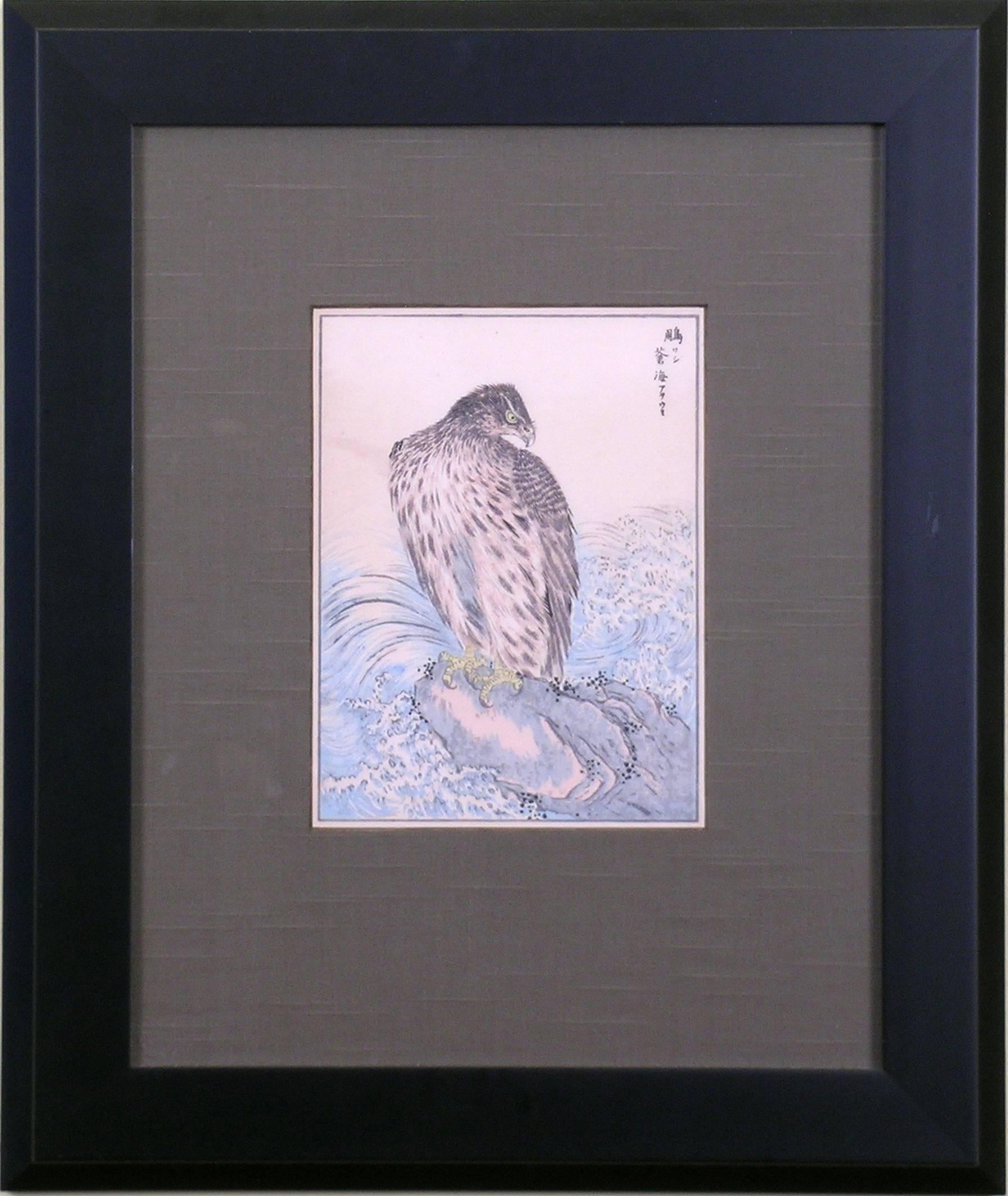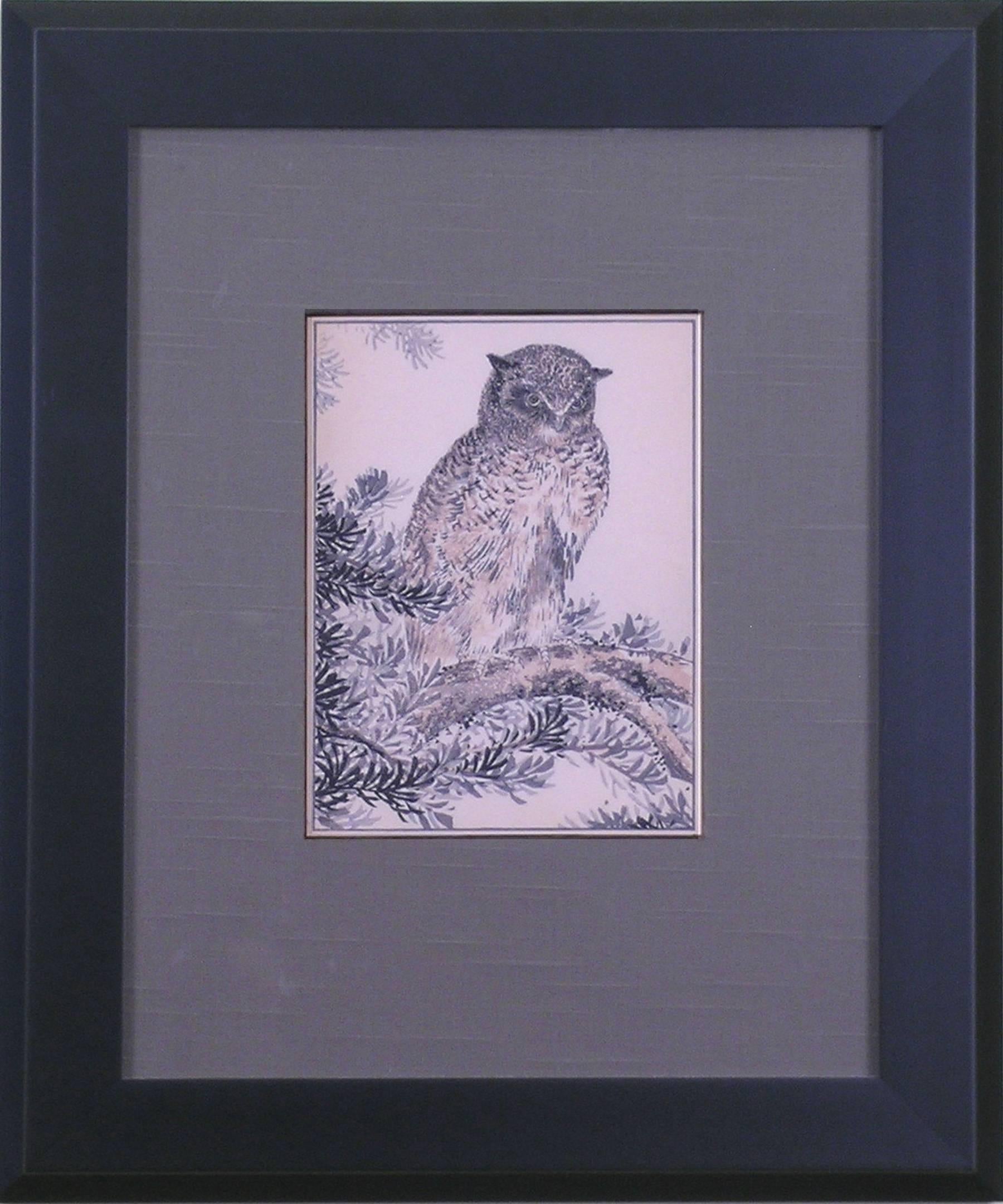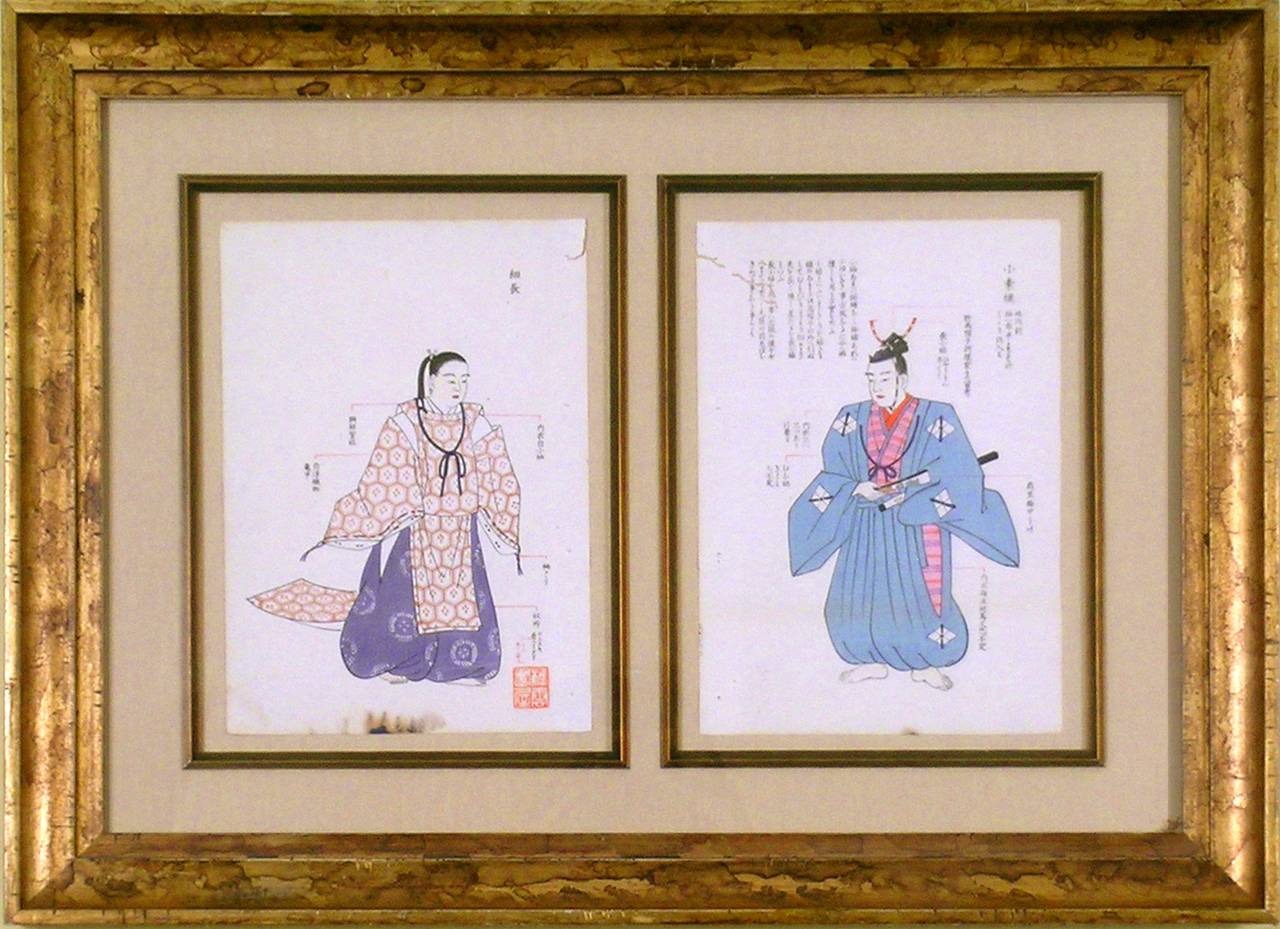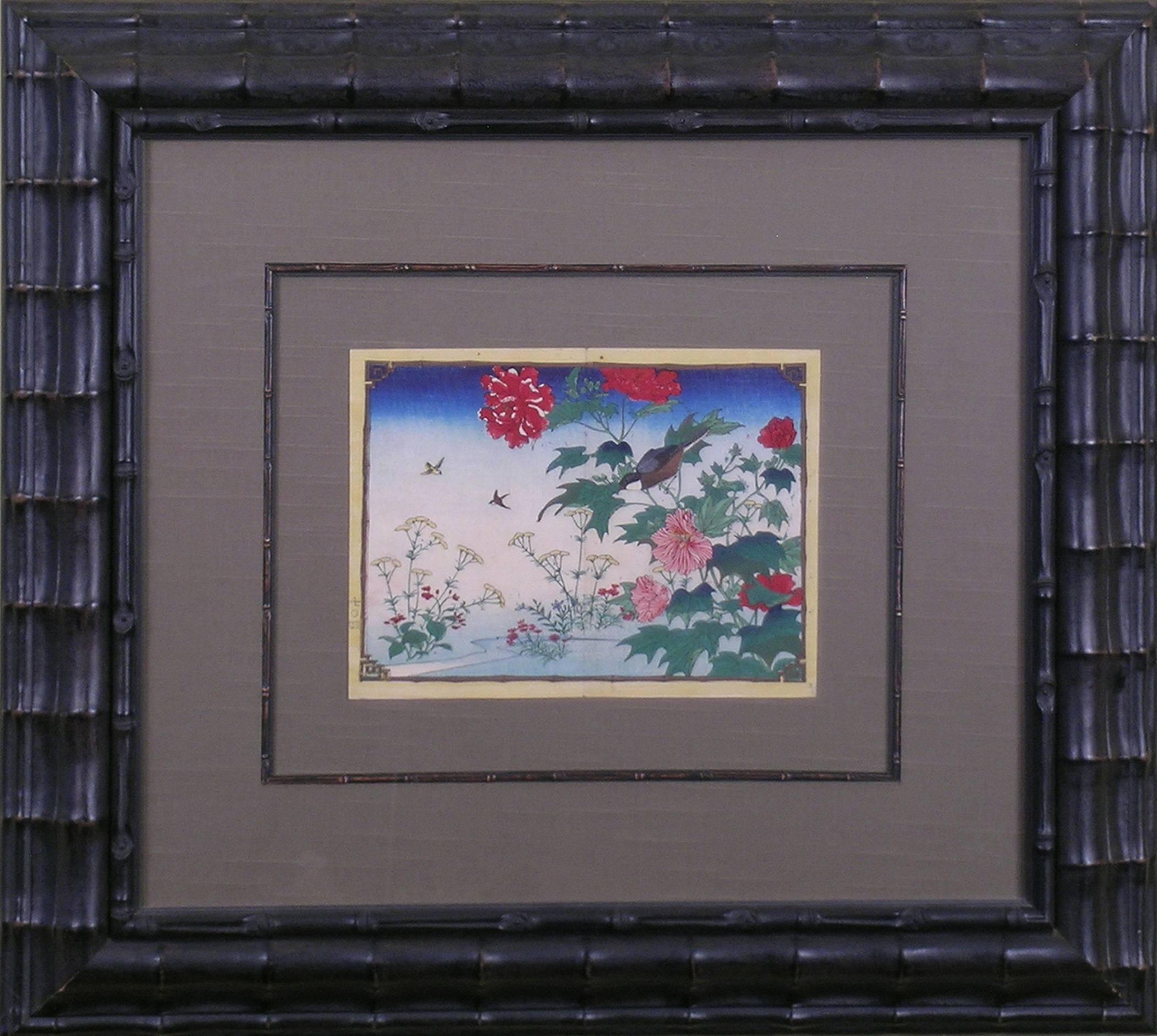Items Similar to Transport: Litter with 18 Men
Want more images or videos?
Request additional images or videos from the seller
1 of 5
Yosha Zuko FuzuTransport: Litter with 18 Menca 1900
ca 1900
About the Item
Yosha Zuko Fuzu
Meiji 33 (1900)
Writer: Kosugi Onson, Imaizumi Teisuke
Publisher: Yoshikawa Hanshichi
The Japanese litters and palanquins are much more than a practical vehicles for transport. They can also be a symbol of wealth and power. Every detail has a special significance. The quality, quantity, color and design of the hand-made embroidered silk fabrics add to the status of the passenger. The number of oxen needed and the hand-painted design of the palanquin and length of the yokes determine social class. Of course, there are man-powered litters as well. In each illustration we see the robe, sashes and hats worn by the carriers all adding to the worth of the patron. Of special significance is the color saffron denoting great extravagance. Each example holds a fascination in the meticulous attention to the smallest addition of a piece of trim and in the way a single knot is tied.
This work illustrates finely made and ornamented covered litters and palanquins to be carried by as many 15 men or several oxen. Every detail and movement is directed by additional staff. Only a very important individual could afford such extravagance.
Woodblock printing flowered in the Edo Period, mid to late 19th century, and is still considered an art form of great precision and beauty. The illustrations of these carts capture both the vitality and life inherent in the images of man, beast and carriage in each color woodblock print. Following the artist sketch, an image is carved into a block of wood. Black inks form the outline of the subject and color inks are applied to specific areas. The woodblock is then pressed to hand-made screened paper which is then hung dry. The entire process of composing a single image can take weeks.
- Creator:Yosha Zuko Fuzu (Japanese)
- Creation Year:ca 1900
- Dimensions:Height: 21 in (53.34 cm)Width: 27 in (68.58 cm)
- Medium:
- Movement & Style:
- Period:
- Condition:Clean, crisp image. Beautiful original color. Framed to museum specifications using archival matting, backing, hinging. Glazed with ultra-violet filtering Plexiglas.
- Gallery Location:Florham Park, NJ
- Reference Number:
About the Seller
5.0
Vetted Seller
These experienced sellers undergo a comprehensive evaluation by our team of in-house experts.
1stDibs seller since 2014
161 sales on 1stDibs
Typical response time: 2 hours
- ShippingRetrieving quote...Ships From: Florham Park, NJ
- Return PolicyA return for this item may be initiated within 1 day of delivery.
More From This SellerView All
- Samurai: Looking OnLocated in Florham Park, NJSamurai Warriors Meji 33 ( 1900) Woodblocks Original Hand-Color Woodblock printing flowered in the Edo Period in Japan, mid to late 19th century, and is still considered an art...Category
Early 1900s Academic Prints and Multiples
MaterialsWoodcut
- Red Men's Kimono DesignBy Matsui YuokuLocated in Florham Park, NJREISHIN GACHO (Album of Beautiful Designs) Japanese Kimono Designs Matsui Yuoku, Painter Japan, 1900 (Meiji 33) Honda Ichijirou, Publisher Woodblock P...Category
Early 1900s Academic Prints and Multiples
MaterialsWatercolor, Woodcut
- HawkBy Kono BaireiLocated in Florham Park, NJKono Bairei (1844 – 1895) Kacho-ga. (Birds and Flowers) Japan, c1880 Woodblock Print. 15 x 11. Okura Magobei, Publisher. The enthusiasm for nature prints transcends the centuries. “One Hundred Flowers” is a mid-nineteenth century work illustrating varieties of flowers in naturalistic styles. Traditional woodblock printing enhances the beauty of each work. The artist must carve different woodblocks for every color he wishes to transfer to paper. In this style of printing it is imperative that the register of each woodblock be exact as they must match perfectly to create an image without blurring. In addition to his illustrated flower books...Category
Late 19th Century Academic Prints and Multiples
MaterialsWatercolor, Woodcut
- OwlBy Kono BaireiLocated in Florham Park, NJKono Bairei (1844 – 1895) Kacho-ga. (Birds and Flowers) Japan, c1880 Woodblock Print. Okura Magobei, Publisher. The enthusiasm for nature prints transcends the centuries. “One Hundred Flowers” is a mid-nineteenth century work illustrating varieties of flowers in naturalistic styles. Traditional woodblock printing enhances the beauty of each work. The artist must carve different woodblocks for every color he wishes to transfer to paper. In this style of printing it is imperative that the register of each woodblock be exact as they must match perfectly to create an image without blurring. In addition to his illustrated flower books...Category
Late 19th Century Academic Prints and Multiples
MaterialsWatercolor, Woodcut
- Lavendar Kimono, Blue KimonoBy Matsui YuokuLocated in Florham Park, NJREISHIN GACHO (Album of Beautiful Designs) Japanese Kimono Designs Matsui Yuoku, Painter Japan, 1900 (Meiji 33) Honda Ichijirou, Publisher Woodblock Prin...Category
Early 1900s Academic Prints and Multiples
MaterialsWatercolor, Woodcut
- Kachoga -- Flowers and BirdsLocated in Florham Park, NJJapanese Woodblocks. Meji Period. Circa 1895. The enthusiasm for nature prints has spanned the centuries. By the mid-nineteenth century these works, illustrating varieties of f...Category
Late 19th Century Academic Prints and Multiples
MaterialsWatercolor, Woodcut
You May Also Like
- Greek Architecture Blueprint of Ancient Amphitheatre Cyanotype Print, WatercolorBy Kind of CyanLocated in Barcelona, ESThis is an exclusive handprinted limited edition cyanotype. Details: + Title: Ancient Roman Amphitheater + Year: 2022 + Edition Size: 50 + Stamped and Certificate of Authenticity provided + Measurements : 70x100 cm (28x 40 in.), a standard frame size + All cyanotype prints...Category
2010s Academic Still-life Photography
MaterialsPhotographic Film, Woodcut, Emulsion, Watercolor, C Print, Color, Lithog...
- Louis I of France as a Roman Emperor, in profile to the rightBy Christoffel JegherLocated in Fairlawn, OHLouis I of France as a Roman Emperor, in profile to the right Chiaroscuro woodcut, 1631-1633 Unsigned (as usual) After a drawing by Hubert Goltzius (1526-1583)...Category
17th Century Academic Portrait Prints
MaterialsWoodcut, ABS
- Tetbury Church - Signed Lithograph, Royal Art, Royal Heritage, Cotswolds, BritishLocated in Knowle Lane, CranleighTetbury Church by His Majesty King Charles III - Hand Signed Limited Edition Lithograph. Belgravia Gallery has been honoured to be associated with ...Category
1990s Academic Landscape Prints
MaterialsLithograph
- Overlooking Wadi, Saudi Arabia - Signed Lithograph, Royal Art, Mountains, AsirLocated in Knowle Lane, CranleighOverlooking Wadi, Asir Province, Kingdom Of Saudi Arabia by His Majesty King Charles III, (created when he was HRH The Prince of Wales) - ...Category
Early 2000s Academic Landscape Prints
MaterialsLithograph
- Windsor Castle - Signed Lithograph, Royal Art, Royal Homes, Windsor Castle, BritishLocated in Knowle Lane, CranleighWindsor Castle by HM King Charles III - Hand Signed Limited Edition Lithograph. Belgravia Gallery has been honoured to be associated with the artwo...Category
1990s Academic Landscape Prints
MaterialsLithograph
- Hong Kong from HMY Britannia - Signed Lithograph, Royal Art, Union Jack,Located in Knowle Lane, CranleighHong Kong From HMY Britannia by HM King Charles III - Hand Signed Limited Edition Lithograph. Belgravia Gallery has been honoured to be associated ...Category
Early 2000s Academic Landscape Prints
MaterialsLithograph
